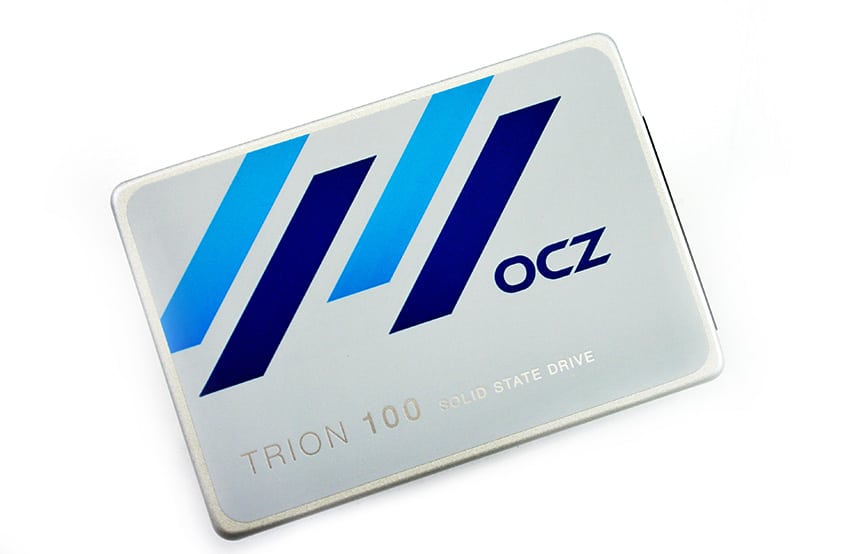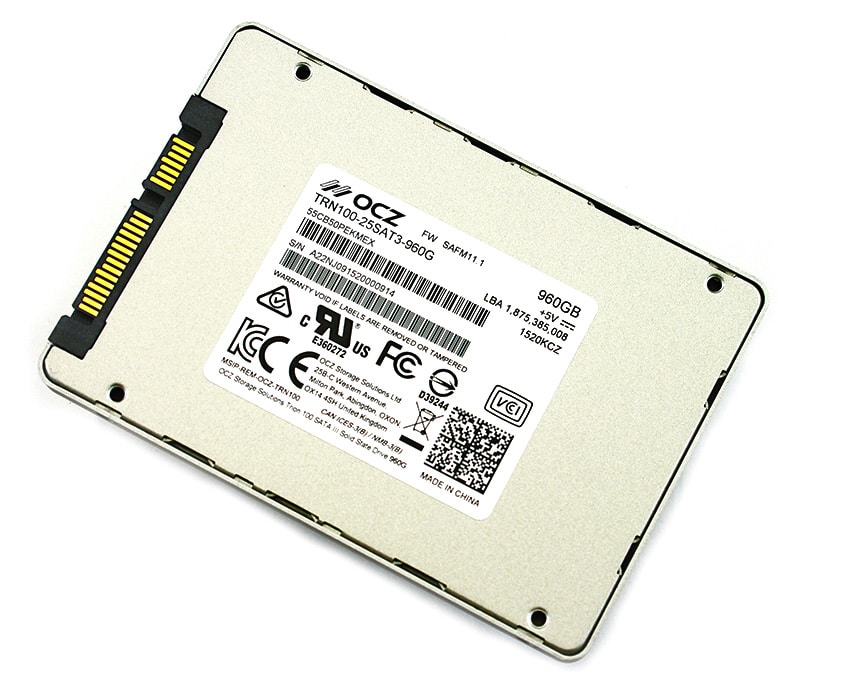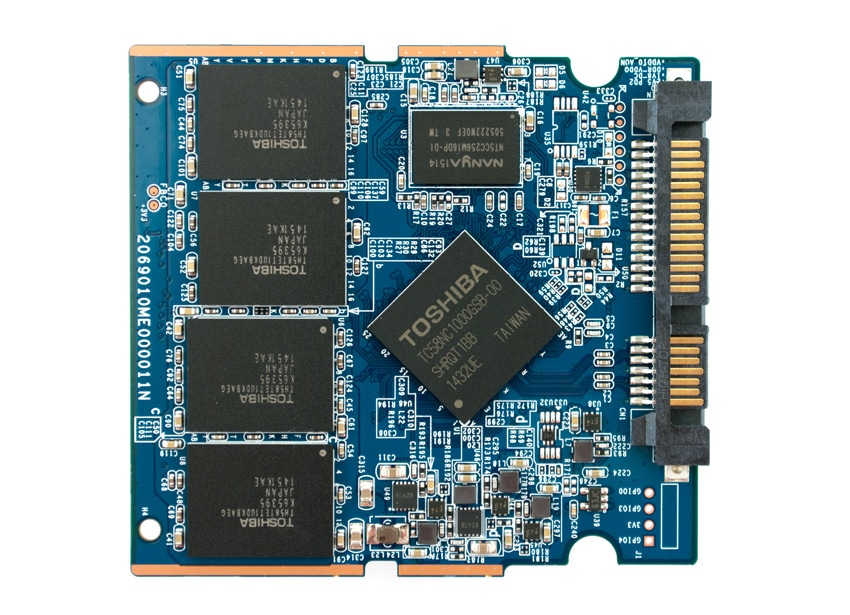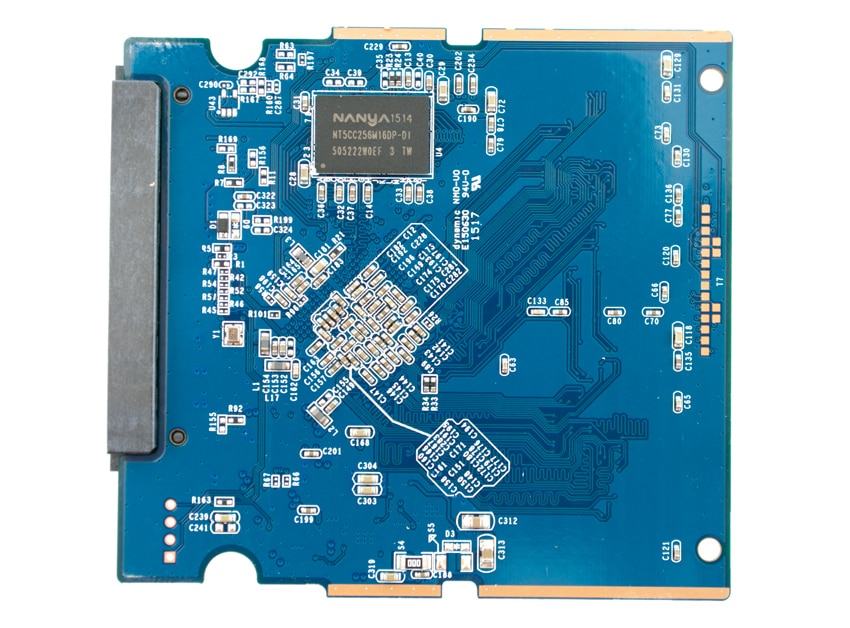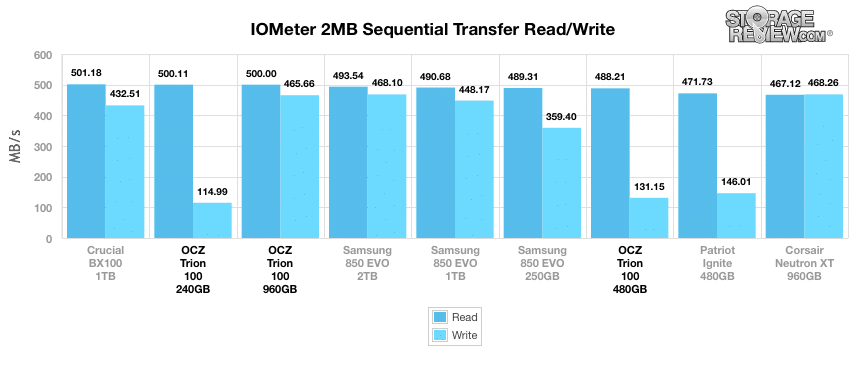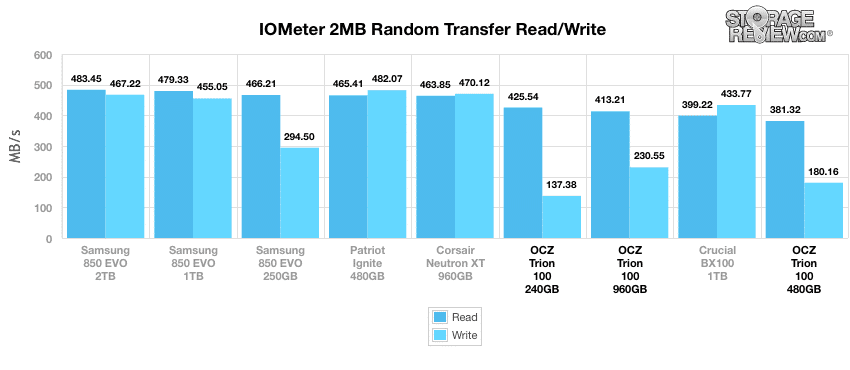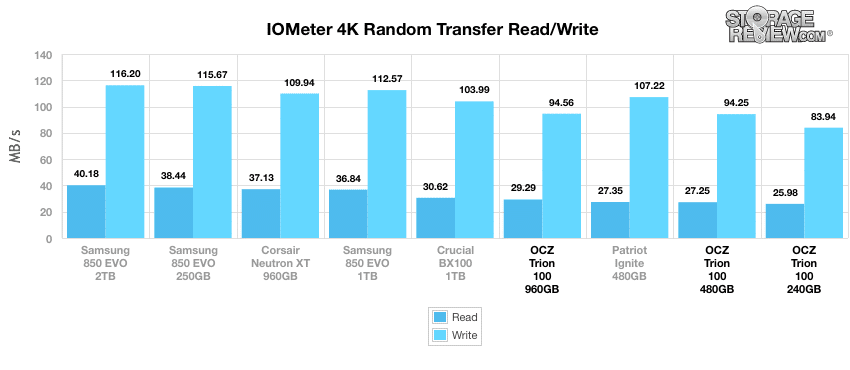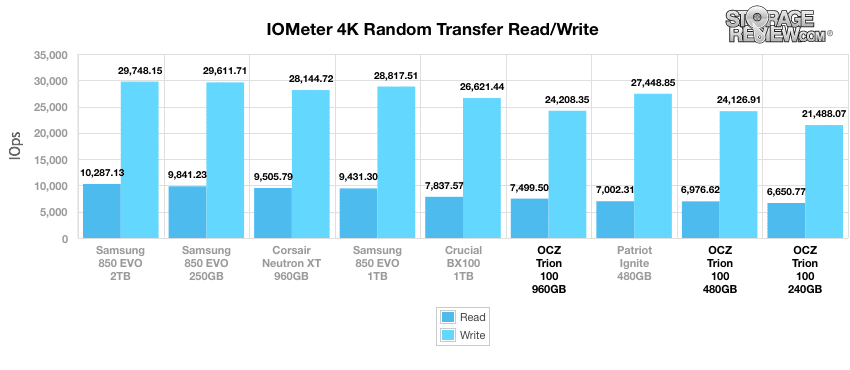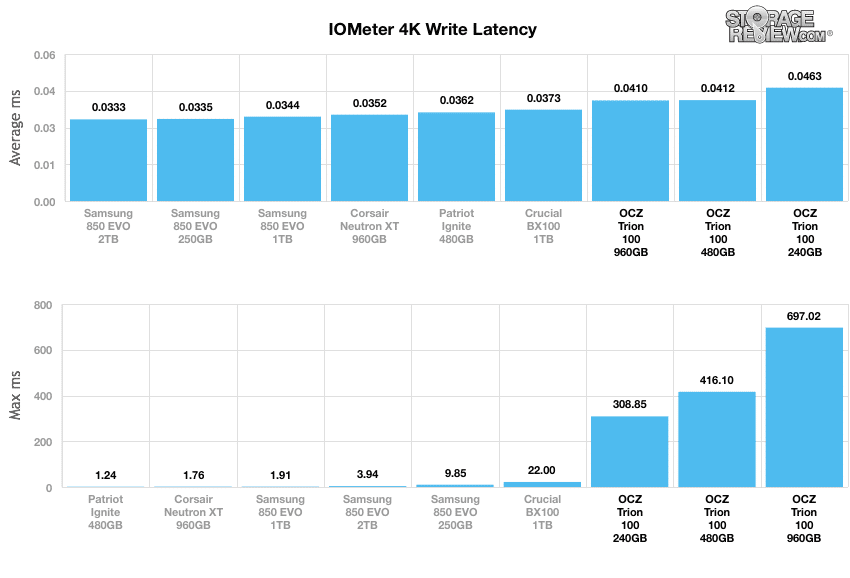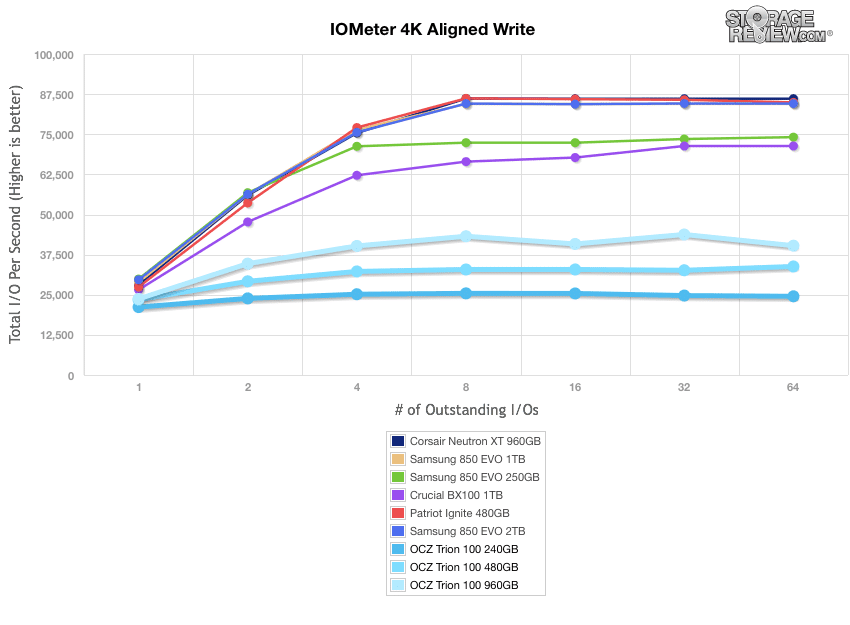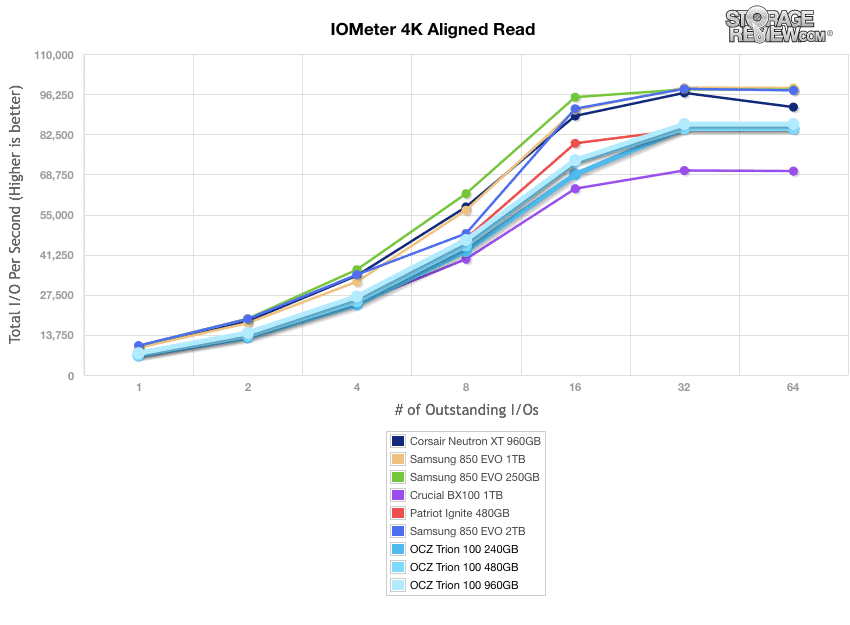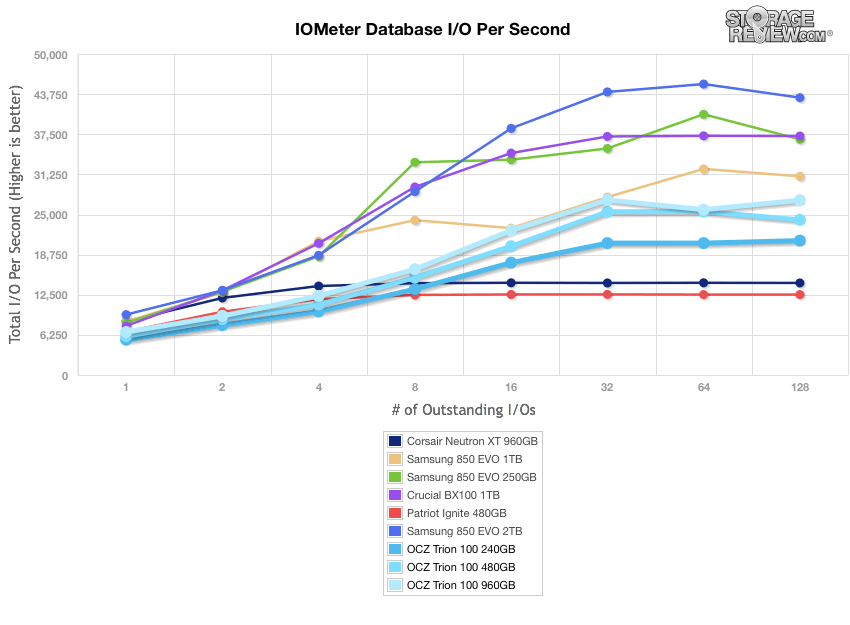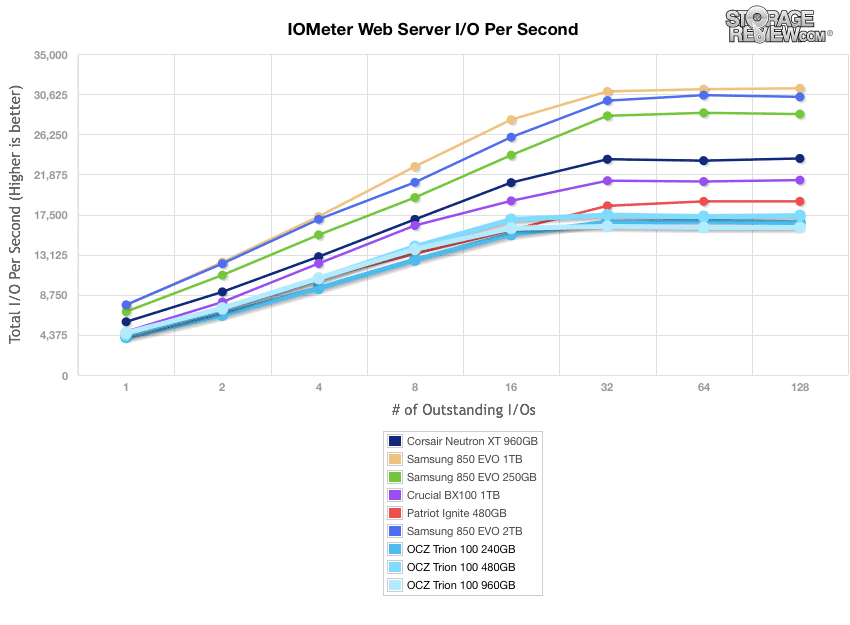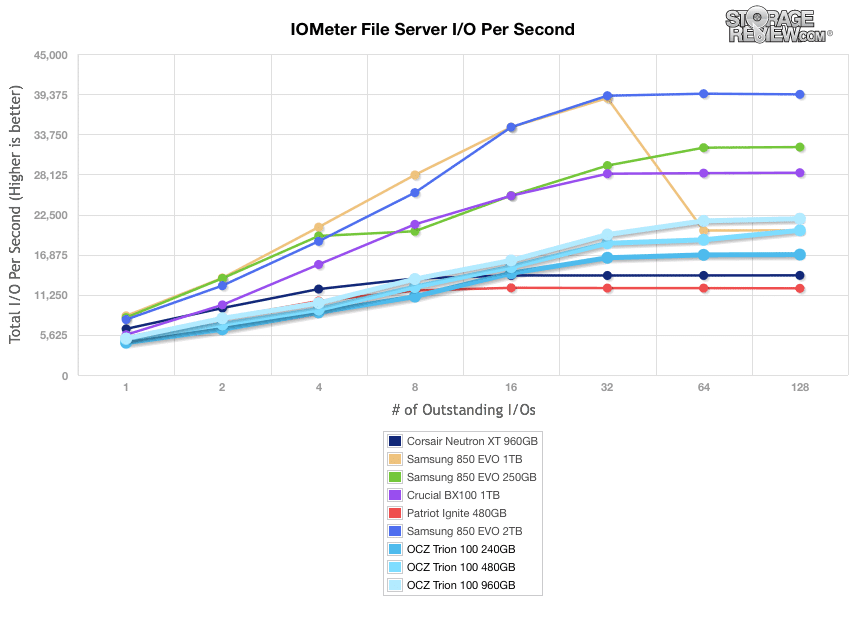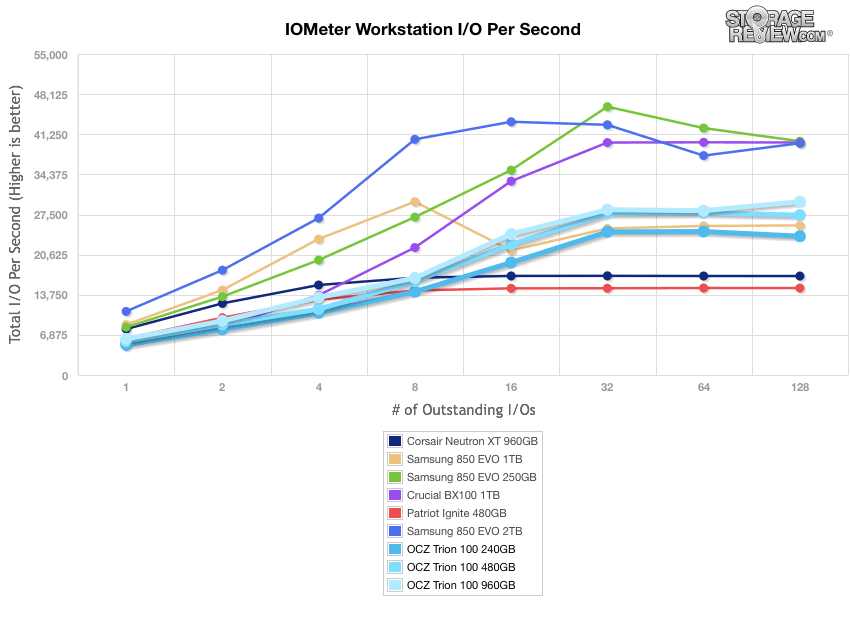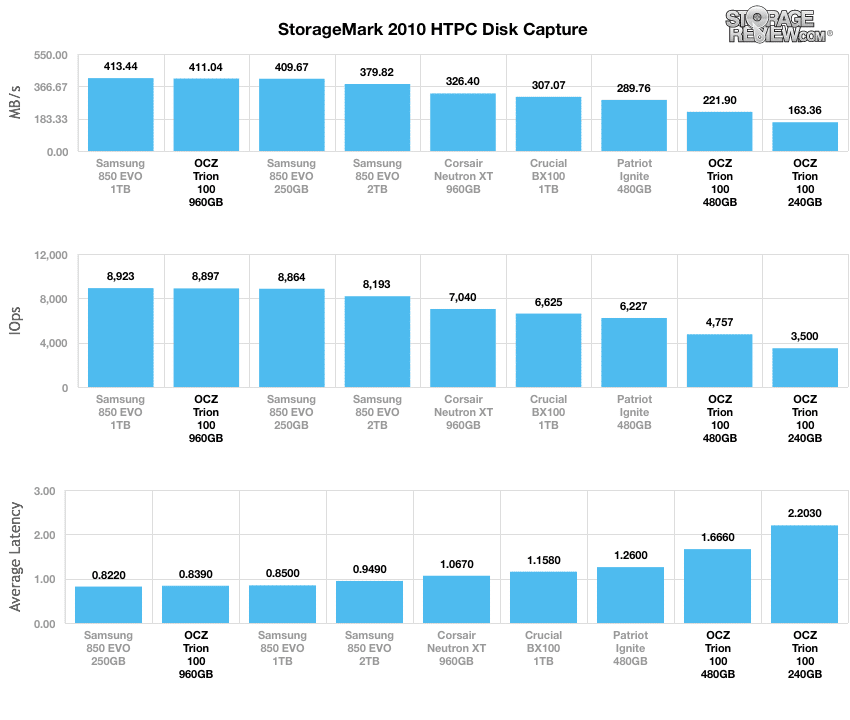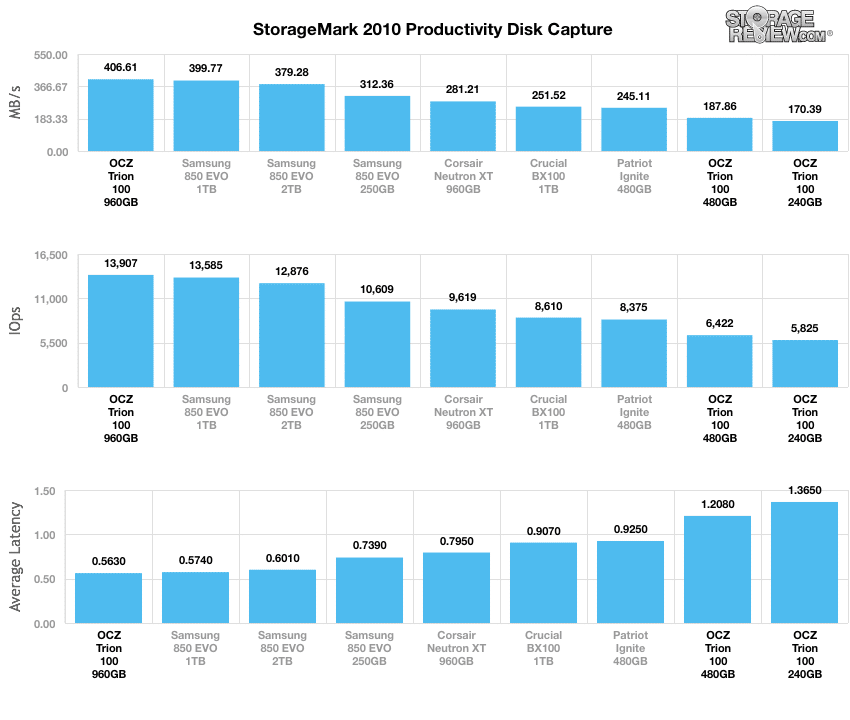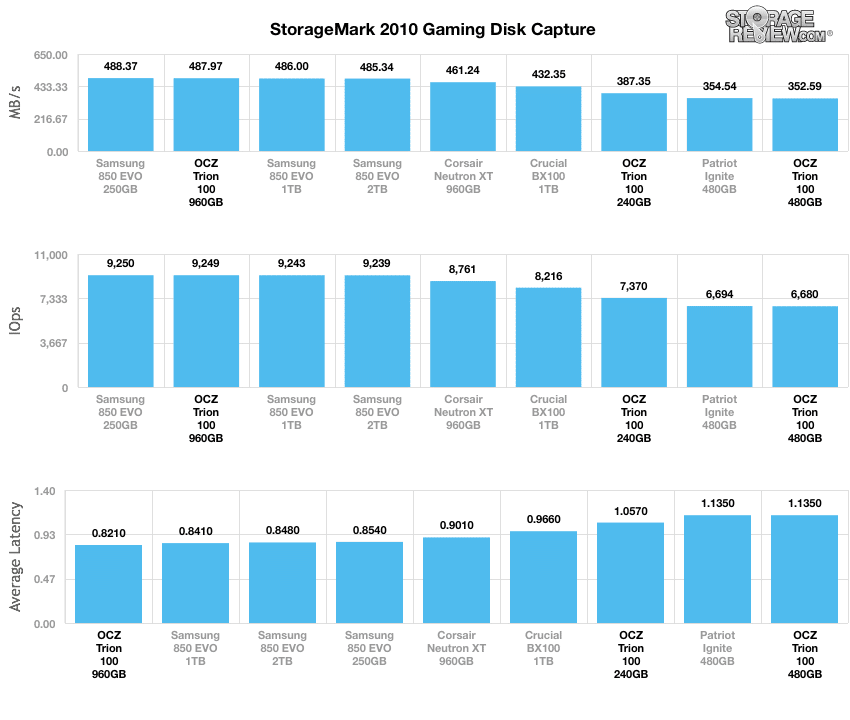
The Trion 100 Series is OCZ’s newest addition to their portfolio of value-oriented SSDs and the first OCZ drive that features next-gen TLC Toshiba TLC NAND flash technology. OCZ has stated that the Trion is not a replacement to the similarly classed ARC line of SSDs, but a complementary release targeted towards an even more cost-sensitive demographic (the lowest capacity is priced at just $57). Though they aren’t going to convince power-consumers to purchase the drive over premium SSDs such as the Samsung EVO, it still a viable option for a lot of people. This is a drive that is targeting the HDD upgrade market, all the while making SSDs more accessible to the mainstream consumer market.
The Trion 100 series is comprised of a 2.5 inch form-factor and is designed for both mobile (consumer and ultra-thin notebooks) and desktop (budget system builds, entry-level gaming systems) applications. Besides the price tag, the new OCZ drive separates itself from the rest of the consumer drive market with its remarkable 219GB/day endurance rating for the 960GB capacity, giving users the peace of mind that they won’t be running out of write cycles any time soon. When looking at its performance specifications, the Trion Series is equipped with technology to optimize its battery life with its lower energy consumption and efficiency. In addition, the highest capacity is quoted by OCZ to boast upwards of 550MB/s read and 530MB/s write, while 4K random read and write IOPS hit 90,000 and 64,000 respectively.
The Trion 100 is also bundled with OCZ’s extensive ShieldPlus, which is described in detailed here. This plan is essentially OCZ’s answer to consumer frustrations when it comes to support and warranty claims by eliminating the endless return loops and removing all shipping costs. Users simply need to provide OCZ support with the Trion SSD’s serial number; no original purchase receipt is needed. If the drive is determined to be defective, OCZ will replace it with a brand new SSD in advance of receiving the bad drive. Couple all of this with a paid return shipping label to minimize expenses and downtime, OCZ has clearly the best warranty policy on the market. This feature alone makes this line of SSDs worth the purchase.
The Trion 100 Series is available in capacities of 120GB, 240GB, 480GB, and 960GB priced at roughly $57, $88, $184, and $369, respectively.
Trion 100 Series Specifications
- Capacities: 120GB, 240GB, 480GB, and 960GB
- Controller: Toshiba
- Flash Technology: Toshiba A19 TLC
- Max Read: 550MB/s
- Max Write: 530MB/s (960GB, 480GB), 520 MB/s (240GB), 450MB/s (120GB)
- Random Read IOPS: 90,000, 79,000 (120GB)
- Random Write IOPS: 64,000 (960GB), 54,000 (480GB), 43,000 (240GB), 25,000 (120GB)
- Endurance: Up to 219GB/day
- DEVSLP Power: 6mW
- Active Power: 4.8W
- MTBF: 1.5M
- TBW: 30TB, 60TB, 120TB, 240TB
- Warranty: 3-year ShieldPlus
Design and Build
The Trion 100 consists of an all-alloy build in an ultra slim, 2.5 inch form factor. The design of OCZ drive is virtually identical to that of the company’s other consumer SSDs, only with a different color scheme. The enclosure of the Trion 100 consists of a light-grey build with blue/light blue branding opposed to the Vector 150’s black, white and blue design. Overall, it has a nice minimalistic feel to it.
Turning the Trion 100 to its backside shows a standard label, which provides users with all the information they need to know about the drive, including serial numbers, model, and PNs. The sides of the drive have two screw holes each for easy mounting as well.
Its slim form-factor allows the Trion 100 allows it to be compatible for most platforms and use cases; from ultrabooks to desktop PCs. The front of the SSD has a standard SATA power and data interface.
To open up the drive, simply pop the top and bottom pieces of the external case apart. Once this is done, you will see the Toshiba controller TC58 and Toshiba A19nm MLC NAND at front and center of the SSD.
Consumer Synthetic Benchmarks
All consumer SSD benchmarks are conducted with the StorageReview client testing platform. The comparables used for this review include:
- Samsung 850 EVO 2TB (SATA, 6Gb/s, Samsung MHX controller)
- Corsair Neutron XT 1TB (SATA, 6Gb/s, Phison PS3110-S10 controller)
- Crucial BX100 1TB (SATA, 6Gb/s, Silicon Motion SM2246EN controller)
- Patriot Ignite 480GB (SATA, 6Gb/s, Phison S10 Series controller)
All IOMeter figures are represented as binary figures for MB/s speeds.
Our first test measures 2MB sequential performance. In this scenario, the Trion 100 240GB model had the best read activity of the three capacities with an impressive 500.11MB/s read (though with only 114.99MB/s write), placing it right at the top of the pack just below the BX100. The top performing Trion 100 drive in the write column was the 960GB model with a speedy 465.66MB/s; it also had an excellent read activity, measuring 500MB/s . The 480GB model posted 131.15MB/s on read making it slightly faster than its 240GB counterpart.
Moving to our 2MB random transfer performance tests, all Trion 100 models ran at the bottom of the pack. That being said, the 240GB model boasted the best read activity again with 425.54MB/s, while the 960GB model posted the best writes with 230.55MB/s.
In IOMeter’s random 4K read and write test told a similar story, with all models performing unsurprisingly under the rest of the compared consumer SSDs with the exception of the Patriot Ignite in reads. Here, the top Trion capacity in both reads and writes (960GB) measured 29.29MB/s and 94.56MB/s, respectively. The 240GB reached 25.98MB/s read and 83.94MB/s write while the 480GB posted 27.25MB/s read and 94.25MB/s write.
When looking at IOPS 960GB capacity posting the best numbers of the OCZ line (7,499.50 IOPS read and 24,208.35 IOPS). As expected, the top performer here was the Samsung 850 EVO 2TB with reads and writes of 10,287.13 IOPS and 29,748.15, respectively.
Our 4K write latency benchmark looks at both the average and maximum readings. Here, the Trion 100 240GB posted 0.0463ms in average latency and 308.852ms in peak. The 480GB posted 0.0413ms (average) and 416.098ms (maximum) while the 960GB model measured 0.0410ms (average) and 697.019ms (maximum).
Our next test shifts a 4k random workload with 100% write activity that scales from 1QD to 64QD. In this aligned scenario, the Trion 100 series posted numbers as low as one third to of those they were compared to. The 240GB model posted a burst speed of 21,153.90 IOPS and only made its way to 24,517.22 IOPS in the terminal. The 960GB model had a range of 23,693.01 IOPS to 40,280.74 IOPS (the best of the Trion 100 series), which was less than half of the next best drive.
Moving on to our aligned read benchmark, all three Trion OCZ capacities moved up on the leaderboard with the OCZ Trion 100 960GB posting a range of 7,482.83 IOPS to 85,987.57 IOPS in the terminal. The other two Trion 100 capacities had virtually identical performance, placing just behind the 960GB model.
Our final consumer synthetic benchmarks compare the drives in a series of mixed server workloads with a queue depth from 1 to 128. Each server profile has a strong bias towards read activity, ranging from 67% read with the database profile to 100% read in the web server profile.
The database profile features a 67% read and 33% write workload focusing on transfers around 8K in size. Here, the top Trion 100 capacity was the 960GB model, measuring a range of 6,684.12 IOPS to 27,226.73 IOPS in the terminal, which placed it in the upper middle part of the leaderboard. The Trion 100 240GB drive posted the slowest results, with a range of just 5,493.75 IOPS to 20,934.26 IOPS.
Our next benchmark is the web server profile is read-only with transfer sizes ranging from 512B to 512KB. The 480GB model was the top OCZ Trion drive in this scenario with a terminal IOPS of 17,383.85. Both of the other capacities had similar results.
The file server profile has 80% read and 20% write workload spread out over multiple transfer sizes ranging from 512-byte to 64KB. The top performing Trion drive was the 960GB capacity, a range of 5,115.74 IOPS and 21,905.07 IOPS in the last queue depth. The 240GB capacity had the lowest results of the three, though it performed better than the Corsair Neutron XT and Patriot Ignite SSDs.
The last profile looks at workstation activity, with a 20% write and 80% read mixture using 8K transfers. In this scenario, the Trion drives posted results placing them all just above the Corsair Neutron XT and Patriot Ignite SSDs again with the 960GB model boasting numbers that were the best of the three (29,697.10 IOPS in the terminal).
Consumer Real-World Benchmarks
While the results of synthetic benchmarks are important to identify the key strengths and weaknesses of a drive, performance in these tests does not always translate directly into real-world situations. To get a better idea how the OCZ Trion 100 drives will handle itself in the field we will chart StorageMark 2010 HTPC, Productivity, and Gaming traces against comparable drives. Higher IOPS and MB/s rates with lower latency times are preferred.
The first traced is based on use as a Home Theater PC (HTPC). The test includes playing one 720P HD movie in Media Player Classic, one 480P SD movie playing in VLC, three movies downloading simultaneously through iTunes, and one 1080i HDTV stream being recorded through Windows Media Center over a 15 minute period.
In our HTPC profile, the Trion 100 picked up its performance significantly, with 8,896.82 IOPS 411.04MB/s, and an average latency 0.839ms for the 960GB model, placing it at the top of our leaderboards. However, the 240GB and 480GB had weaker performance, placing them at the bottom of the pack.
The next trace simulates disk activity in an office workstation or productivity scenario. This test includes three hours of operation in an office productivity environment with 32-bit Windows Vista running Outlook 2007 connected to an Exchange server, web browsing using Chrome and IE8, editing files within Office 2007, viewing PDFs in Adobe Reader, an hour of local music playback, and two hours of streaming music via Pandora.
Our Productivity trace told a similar story, with the 960GB Trion 100 boasting a bar-setting 13,906.72 IOPS, 406.61MB/s, and an average latency of 0.563ms for top honors on our leaderboard. Again, the other two Trion 100 SSDs showed numbers that were less than half of their higher capacity brethren during this profile.
The final consumer real-life benchmark simulates disk activity during gaming. This simulation taxes the drive’s read performance, with 6% write operations and 94% read operations. The test consists of a Windows 7 Ultimate 64-bit system pre-configured with Steam, with Grand Theft Auto 4, Left 4 Dead 2, and Mass Effect 2 already downloaded and installed. The trace captures the heavy read activity of each game loading from the start, as well as textures as the game progresses.
Results were again more or less the same in our gaming profile, with the 960GB Trion 100 boasting very impressive numbers: 9,248.8 IOPS, 487.97MB/s, and 0.821ms, trailing just the Samsung EVO 250GB. The other two capacities remained at the bottom of the pack by a significant margin.
Conclusion
The Trion 100, OCZ’s first drive to feature Toshiba’s TLC NAND, is the company’s most affordable line of SSDs to date, allowing consumers to purchase a solid-side drive for as low as $57. This certainly brings even more mainstream accessibility to the SSD market and thus will sway a lot of economically-minded people to move in that direction. Like all OCZ drives, Trion 100 features the company’s new ShieldPlus program, which sets the bar for consumer-grade SSD warranty programs. Consumers with a potentially defective drive simply have to provide OCZ support with the SSD’s serial number with no original purchase receipt required. If the drive is faulty, consumers will have a new one shipped to them immediately as well as a paid return shipping label. This return policy is a huge added benefit, as it eliminates a lot of potential for future headaches.
When it comes to its performance, however, the results were very uneven, as it placed the three capacities all over the board. During our synthetic tests, the 240GB model posted the best read activity of the three capacities during our 2MB sequential tests with an impressive 500.11MB/s; however, it only recorded 114.99MB/s in write activity. The 960GB Trion 100 had the best overall performance with 500.00MB/s read and 456.66MB/s write, which ranked it just behind the BX100 drive. When looking at random transfer rates of the same file size, all Trion 100 models placed at the bottom of our leaderboard in both reads and writes. In addition, our mixed server workloads (database, web server, file server, and workstation) results were fairly inconsistent, with all capacities placing either at the bottom or the middle of the pack. Moving to our consumer real-world benchmarks showed the biggest disparity between the three capacities: the 960GB model was a top performer among the tested consumer drives, while the 480GB and 240GB capacities ranked at the bottom of the pack. This was highlighted by our productivity trace where the 960GB Trion 100 boasted numbers that were than twice as fast as its smaller capacities brothers with a bar-setting 13,906.72 IOPS, 406.61MB/s, and an average latency of 0.563ms.
Overall, the Trion 100 series of SSDs, with its inexpensive price tag and market leading warranty ShieldPlus program, is certainly an attractive option for consumers looking to upgrade from an HDD.
Pros
- Market leading warranty program
- Inexpensive
- Excellent real-world performance for the 960GB capacity
Cons
- Poor overall synthetic performance
- Smaller capacities also had a very weak showing during our real-world tests
Bottom Line
The OCZ Trion 100 offers an industry leading warranty program and is a viable option for those looking for an inexpensive way to upgrade their platter HDD-based system.

